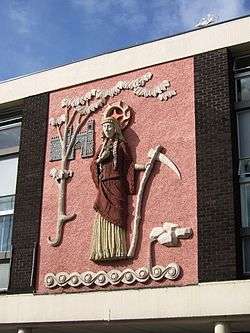Saint Sidwell
Sidwell (Latin: Sativola) was a virgin saint from the English county of Devon, possibly of British origin.[1] She is the patron saint of Exeter but her historical existence is not well established.
Saint Sidwell | |
|---|---|
 The relief of Saint Sidwell on a shopping arcade in Sidwell Street, Exeter. | |
| Died | Sixth century? |
| Venerated in | Roman Catholic Church |
| Feast | 1 August |
| Attributes | Scythe; Holy Well; Lammas |
Cult and iconography
The cultus of Sidwell has been active at Exeter from early times. Pilgrims were visiting her shrine by 1000, and their activity is mentioned both by John Leland and William Worcestre. The Catalogus Sanctorum Pausantium in Anglia describes her as a native of Exeter who was beheaded by reapers, who were incited so to do by her stepmother. This legend bears a striking similarity to that of both Saint Urith and Saint Juthwara, her supposed sister. She is said to have been buried outside the city, where the sick could be healed at her grave. The Church of St Sidwell, located just outside the site of Exeter's east gate, is still extant, though it was largely rebuilt after being bombed during the Second World War. The site also once had a well at which cures are believed to have been effected. One of the main streets in Exeter is Sidwell Street.
In addition, a church at Laneast in Cornwall is dedicated to Sidwell, though the dedication appears to only date from the fifteenth century (the additional patron, Saint Gulval, really belongs to Lanisly (now Gulval) and was only added in the eighteenth century). Here, too, is a holy well, though without dedication.
In art, Sidwell is represented with a scythe and a well at her side. St Sidwells, formerly a village outside Exeter, bears her name and she appears in stained glass in Exeter Cathedral as well as in the chapel at Oxford's All Souls College and the parish church of Ashton in Devon. She is also depicted on at least seven painted rood screens around the same county. Sidwell's feast day is variously given as 31 July, 1 August and 2 August. The sculpture in Sidwell Street (see right) was created by Bideford artist Fred Irving in 1969 and is made of fibreglass.
References
- Monks of Ramsgate. “Sidwell”. Book of Saints, 1921. CatholicSaints.Info. 1 August 2016

Sources
- Farmer, David Hugh (1978). The Oxford Dictionary of Saints. Oxford University Press.
Further reading
- Förster, Max. "Die heilige Sativola oder Sidwell." Anglia 62 (1938): 33–80.